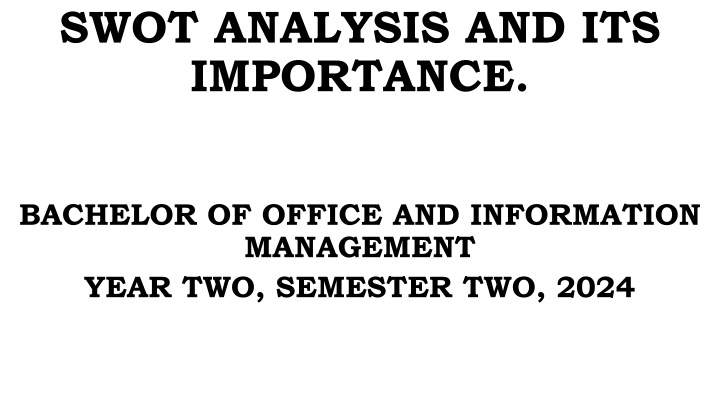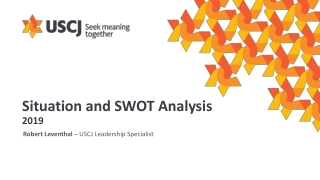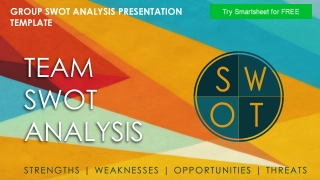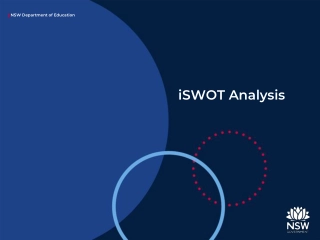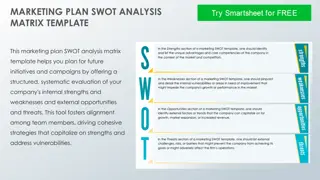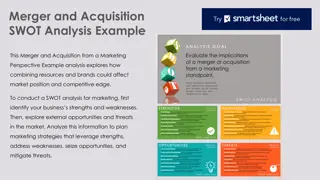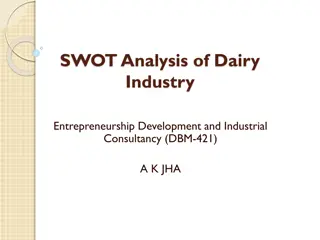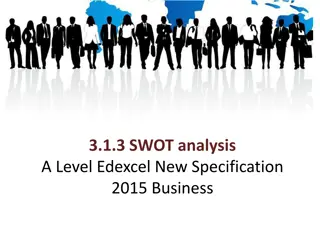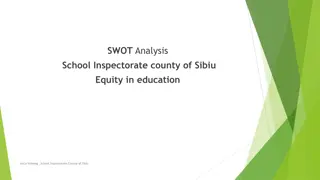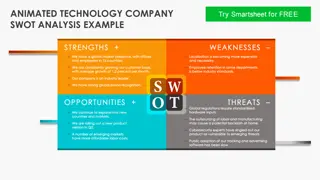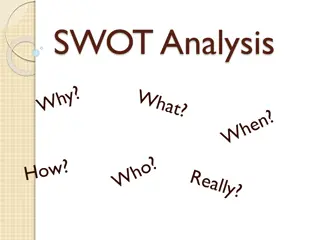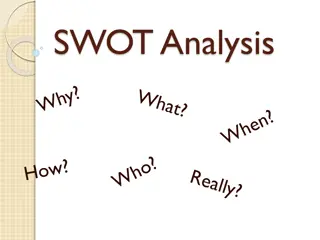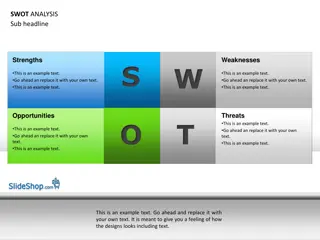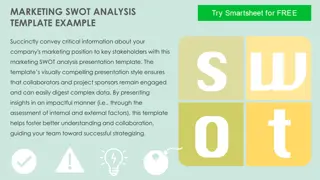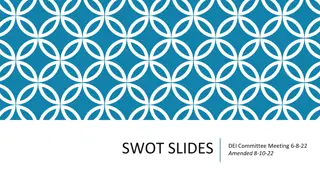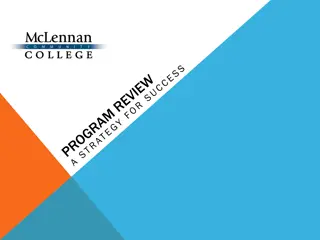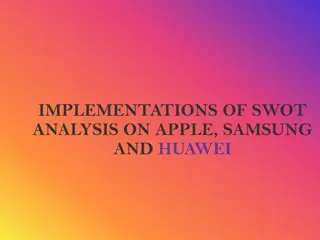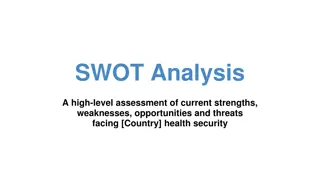Importance of SWOT Analysis in Business
SWOT Analysis is a vital tool for identifying strengths, weaknesses, opportunities, and threats that impact an organization's strategic planning. It helps in aligning resources with the competitive environment, enabling firms to leverage internal strengths and mitigate external risks.
Download Presentation

Please find below an Image/Link to download the presentation.
The content on the website is provided AS IS for your information and personal use only. It may not be sold, licensed, or shared on other websites without obtaining consent from the author.If you encounter any issues during the download, it is possible that the publisher has removed the file from their server.
You are allowed to download the files provided on this website for personal or commercial use, subject to the condition that they are used lawfully. All files are the property of their respective owners.
The content on the website is provided AS IS for your information and personal use only. It may not be sold, licensed, or shared on other websites without obtaining consent from the author.
E N D
Presentation Transcript
SWOT ANALYSIS AND ITS IMPORTANCE. BACHELOR OF OFFICE AND INFORMATION MANAGEMENT YEAR TWO, SEMESTER TWO, 2024
SWOT ANALYSIS Each letter in SWOT analysis stand for its specific meaning.The letter represent the following meaning. Strength Weakness Opportunity Threats A SWOT analysis is that tool that identifies Strengths, Weakness, Opportunity and Threats that an organization face.
SWOT Analysis is also sometimes known as SWOC Analysis where S stands for Strength W Weakness O Opportunity C as Constraints which actually same as threats. SWOT Analysis provide information that is helpful in matching firms resources and capabilities to the competitive environment that a firm operates. The strengths and weaknesses come from within the firm while threats and opportunities arise on the external environment that a firm serves.
STRENGTH These are the characteristics of the business that gives it an advantage over others. They are the qualities that enable a firm to accomplish its mission. These are the basis on which continued success can be made and continued/sustained. A firm need to ask its self the following questions; i. What advantage does the firm have that others donot have? Ii. What do they do better than any one else? Iii. What personnel resources do they have access to?
POTENTIAL INTERNAL STRENGTHS INCLUDE THE FOLLOWING I. Adequate financial Resources II. Super Technology Skills III. Strong distribution Channels IV. Customer loyalty V. Better manufacturing Capabilities VI. Strong advertisement Campaign VII.Protection from competitive pressure
WEAKENESSES These are the limitations/ characteristics that places a firm at disadvantage relative than others. They result to strategic disadvantage. They prevent a firm to accomplish its mission and achieving the pull potential. These weakenesses detoriate influences on the organizational success and growth. POTENTIAL INTERNAL WEAKNESSES (EXAMPLES OF FIRMS WEAKNESS) Lack of managerial depth and talents Poor reputation of the firm Weak distribution network Too narrow productline( Producing one product instead of multiple products Unreliable products/services Weak marketing image resulting to weak brands
OPPORTUNIES This refers to the favourable conditions in the environment that a firm operates on that provides a chance for an organization to make a greater profit. They arise to the external environment of the firm. Opportunies do not come frequently, therefore the management must exploit them immediately without delay. Each opportunity must be analysed in terms of Profitability POTENTIAL OPPORTUNIES (EXAMPLES OF OPPORTUNITIES) Changing customer tastes Technology advances New distribution channel Change in social pattern, population profile, life cycle change.
THREATS These are unfavorable conditions in the environment that the business operates. They create risk to the firm. POTENTIAL THREATS(EXAMPLES OF THREATES) Slower market growth Rising sales of substitute products Technology Advances Changing in customers tastes and needs Adverse demographic changes
IMPORTANCE OF SWOT ANALYSIS It is the source of information for strategy planning It builds an organisational strength It reverse organizational weaknesses It maximizes firms response to opportunity It identify the core competencies of the firm It helps in setting to objectives or strategic plan It helps to know the past, present and the future.
LIMITATION OF SWOT ANALYSIS A SWOT Analysis may be limited because; It doesn t priotize issues It doesn't provide solutions or offer alternative decisions It can generate too many ideas but doesnot help in choosing which one is the best. It can produce a lot of information, but not all of it is usefull.
ADVANTAGES OF SWOT ANALSYSIS It facilitates an understanding of the strengths and weaknesses of the organisation. It encourages the development of strategic thinking. It enables senior managers to focus on strengths and build opportunities.
Achieving Competitive advantage by using IS/IT. Achieving Competitive Advantage with IT Off-line (store) Retail Online Retail Automotive Online music Music players Web search Personal computers Software Competitive Advantage Competitiveness How effectively an organization meets the wants and needs of customers relative to others that offer similar goods or services. is an outsourcing solutions design firm with an extensive offering of world-class logistics, fulfillment, customer care and technology infrastructure that can be leveraged to create unique, client-specific business solutions. Outputs Productivity = Inputs Productivity Measures how well an organization is utilizing its resources. Porter s Competitive Advantage Model New Entrants Buyer Power Supplier Power Rivalry Among Competitors Suppliers Customers Substitutes
Achieving Competitive Advantage with Information Systems Porter s Competitive Forces Model Essentials of Management Information Systems Achieving Competitive Advantage with Information Systems Using Information Systems to Achieve Competitive Advantage Porter s Competitive Forces Model One way to understand competitive advantage Five competitive forces shape fate of firmTraditional competitors Competitors in market space continuously devise new products, new efficiencies, switching costs. New market entrantsSome industries have low barriers to entry:E.g., food industry versus microchip industryNewer companies may have advantages:Newer equipment, younger workforce, and so on.
Porters Competitive Forces Model Essentials of Management Information Systems Achieving Competitive Advantage with Information SystemsUsing Information Systems to Achieve Competitive AdvantagePorter s Competitive Forces Model Substitute products and services Substitutes customers can purchase if your prices too high.E.g., Internet music service versus CDs.Customers Can customers easily switch to competitor s products? Can customers force firm and competitors to compete on price alone (transparent marketplace). SuppliersThe more suppliers a firm has, the greater control it can exercise over suppliers.
Porters Competitive Forces Model Essentials of Management Information Systems Achieving Competitive Advantage with Information SystemsUsing Information Systems to Achieve Competitive AdvantagePorter s Competitive Forces Model In Porter s competitive forces model, the strategic position of the firm and its strategies are determined not only by competition with its traditional direct competitors but also by four forces in the industry s environment: new market entrants, substitute products, customers, and suppliers.
Information System Strategies for Dealing with Competitive Forces Essentials of Management Information Systems Achieving Competitive Advantage with Information Systems Using Information Systems to Achieve Competitive Advantage Information System Strategies for Dealing with Competitive Forces Basic strategy: Align IT with business objectives75 percent of businesses fail to align their IT with their business objectives, leading to lower profitability. To align IT: Identify business goals and strategies. Break strategic goals into concrete activities and processes. Identify metrics for measuring progress. Determine how IT can help achieve business goals. Measure actual performance.
Information System Strategies for Dealing with Competitive Forces Essentials of Management Information Systems Achieving Competitive Advantage with Information Systems Using Information Systems to Achieve Competitive AdvantageInformation System Strategies for Dealing with Competitive Forces Low-cost leadership Use information systems to achieve the lowest operational costs and the lowest prices.E.g. Wal-Mart Inventory replenishment system sends orders to suppliers when purchase recorded at cash register. Minimizes inventory at warehouses, operating costs.
Essentials of Management Information Systems Achieving Competitive Advantage with Information Systems Using Information Systems to Achieve Competitive Advantage Supermarkets and large retail stores such as Wal-Mart use sales data captured at the checkout counter to determine which items have sold and need to be reordered. Wal-Mart s continuous replenishment system transmits orders to restock directly to its suppliers. The system enables Wal-Mart to keep costs low while fine- tuning its merchandise to meet customer demands.
Information System Strategies for Dealing with Competitive Forces Essentials of Management Information Systems Achieving Competitive Advantage with Information Systems Using Information Systems to Achieve Competitive Advantage Information System Strategies for Dealing with Competitive Forces Product differentiation Use information systems to enable new products and services, or greatly change the customer convenience in using your existing products and services.E.g., Google s continuous innovations, Apple s iPhone. Use information systems to customize, personalize products to fit specifications of individual consumers. DellMass customization at Lands End
Information System Strategies for Dealing with Competitive Forces Essentials of Management Information Systems Achieving Competitive Advantage with Information Systems Using Information Systems to Achieve Competitive Advantage Information System Strategies for Dealing with Competitive Forces Focus on market niche. Use information systems to enable specific market focus, and serve narrow target market better than competitors. Analyzes customer buying habits, preferencesAdvertising pitches to smaller and smaller target marketsE.g., Hilton Hotel s OnQ SystemAnalyzes data collected on guests to determine preferences and guest s profitability
Information System Strategies for Dealing with Competitive Forces Essentials of Management Information Systems Achieving Competitive Advantage with Information Systems Using Information Systems to Achieve Competitive AdvantageInformation System Strategies for Dealing with Competitive Forces Strengthen customer and supplier intimacy. Strong linkages to customers and suppliers increase switching costs and loyalty Toyota: uses IS to facilitate direct access from suppliers to production schedules Permits suppliers to decide how and when to ship suppliers to Chrysler factories, allowing more lead time in producing goods. Amazon: keeps track of user preferences for purchases, and recommends titles purchased by others
Some companies pursue several strategies at same time. Essentials of Management Information Systems Achieving Competitive Advantage with Information Systems Using Information Systems to Achieve Competitive Advantage Information System Strategies for Dealing with Competitive Forces Some companies pursue several strategies at same time. Dell emphasizes low cost plus customization of products. Successfully using IS to achieve competitive advantage requires precise coordination of technology, organizations, and people.
The Internets Impact on Competitive Advantage Essentials of Management Information Systems Achieving Competitive Advantage with Information Systems Using Information Systems to Achieve Competitive Advantage The Internet s Impact on Competitive Advantage Enables new products and services Transforms industries Increases bargaining power of customers and suppliers Intensifies competitive rivalry Creates new opportunities for building brands and large customer bases
The Business Value Chain Model Essentials of Management Information System Achieving Competitive Advantage with Information Systems Using Information Systems to Achieve Competitive Advantage The Business Value Chain ModelHighlights specific activities in a business where competitive strategies can best be applied and where information systems are likely to have a strategic impact. Primary activities Support activities Benchmarking Best practices
The Value Chain Model Essentials of Management Information Systems Achieving Competitive Advantage with Information Systems Using Information Systems to Achieve Competitive Advantage The Value Chain Model This figure provides examples of systems for both primary and support activities of a firm and of its value partners that would add a margin of value to a firm s products or services.
The Internet and Globalization Essentials of Management Information Systems Achieving Competitive Advantage with Information Systems Competing on a Global Scale The Internet and GlobalizationPrior to the Internet, competing globally was only an option for huge firms able to afford factories, warehouses, and distribution centers abroad. The Internet drastically reduces costs of operating globally. Globalization benefits:Scale economies and resource cost reduction Higher utilization rates, fixed capital costs, and lower cost per unit of productionSpeeding time to market
Global Business and System Strategies Essentials of Management Information Systems Achieving Competitive Advantage with Information Systems Competing on a Global ScaleGlobal Business and System Strategies Domestic exporters Heavy centralization of corporate activities in home country MultinationalsConcentrates financial management at central home base while decentralizing production, sales, and marketing to other countries Franchisers Product created, designed, financed, and initially produced in home country but rely on foreign units for further production, marketing, and human resources TransnationalsRegional (not national) headquarters and perhaps world headquarters; optimizing resources as needed
Global System Configurations Essentials of Management Information Systems Achieving Competitive Advantage with Information Systems Competing on a Global Scale Global System Configurations Centralized systems:All development and operation at domestic home baseDuplicated systems:Development at home base but operations managed by autonomous units in foreign locations Decentralized systems:Each foreign unit designs own solutions and systemsNetworked systems:Development and operations occur in integrated and coordinated fashion across all units
Global Business Organization Systems Configurations Essentials of Management Information Systems Achieving Competitive Advantage with Information Systems Competing on a Global Scale Global Business Organization Systems Configurations The large Xs show the dominant patterns, and the small Xs show the emerging patterns. For instance, domestic exporters rely predominantly on centralized systems, but there is continual pressure and some development of decentralized systems in local marketing regions.
Producer perspective: Essentials of Management Information Systems Achieving Competitive Advantage with Information Systems Competing on Quality and Is Quality? Producer perspective:Conformance to specifications and absence of variation from specs Customer perspective: Physical quality (reliability), quality of service, psychological quality Total quality management (TQM):Quality control is end in itselfAll people, functions responsible for qualitySix sigma: Measure of quality: 3.4 defects/million opportunities
How Information Systems Improve Quality Essentials of Management Information Systems Achieving Competitive Advantage with Information Systems Competing on Quality and Design How Information Systems Improve Quality Reduce cycle time and simplify production process. BenchmarkingUse customer demands to improve products and services. Improve design quality and precision. Computer-aided design (CAD) systemsImprove production precision and tighten production tolerances.
Essentials of Management Information Systems Achieving Competitive Advantage with Information SystemsCompeting on Quality and DesignComputer-aided design (CAD) systems improve the quality and precision of product design by performing much of the design and testing work on the computer. Competing on Business Processes Essentials of Management Information Systems Achieving Competitive Advantage with Information Systems Businesses are collections of business processes ways of working and getting things done. See Chapter 1.Some times they are written in manuals, but in many cases business processes are informal. In order to use information systems effectively, you need to change business processes. Before you can change processes, you need to change people s attitudes and behaviors, and even the organization itself.
Business process management = continuous improvement Essentials of Management Information Systems Achieving Competitive Advantage with Information Systems Competing on Business ProcessesBusiness process management = continuous improvementIdentify processes for change. Analyze existing processes.Design new process. Implement new process.Measure new process. Competing on Business Processes Essentials of Management Information Systems Achieving Competitive Advantage with Information Systems
Essentials of Management Information Systems Achieving Competitive Advantage with Information Systems Competing on Business Processes Business Process Reengineering Essentials of Management Information Systems Achieving Competitive Advantage with Information Systems Competing on Business Processes Business Process Reengineering A radical form of fast change Not continuous improvement, but elimination of old processes, replacement with new processes, in a brief time period Can produce dramatic gains in productivity, but increases organizational resistance to change
